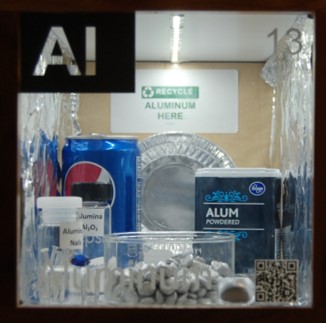Aluminum
 Aluminum or Aluminium? - that is the question
Aluminum or Aluminium? - that is the question
-
Aluminum foil
-
A small aluminum pie pan
-
A piece of aluminum metal
-
Aluminum sample stubs for a Scanning Electron Microscope
-
An aluminum can, usually made from recycled Al. The top of the cans are made from an Aluminum/Magnesium mixture to harden it.
-
Aluminum nails; they are used for shingles, since Al never rusts.
-
Powdered Alumina; Metallic aluminum is reacting easily with oxygen forming a thin layer of alumina Al2O3. This layer is insoluble in water and protects the metallic Al from further oxidation.
- Alum; actually aluminum potassium sulfate, powdered alum is used in the kitchen for canning or pickling. It can also be used to tan leather, as a flocculant (a flocculant is a substance that promotes the clumping of minerals) in purifying water, as a treatment to fireproof textiles, and as an ingredient in aftershave.
- A lab-grown sapphire (donated by Lindsay Young); an aluminum oxide, the chemical formula of sapphire is Al2O3. Although the most common and most easily recognizable color of sapphire is blue, many colors of sapphire exist, including green, pink, orange, and purple!
Fun Fact: There is an ongoing war between American/Canadian Aluminum vs. British English/German Aluminium. Who is correct?
Here is why (posted on World Wide Words, 2006): Sir Humphry made a bit of a mess of naming this new element, at first spelling it alumium (this was in 1807) then changing it to aluminum, and finally settling on aluminium in 1812. His classically educated scientific colleagues preferred aluminium right from the start, because it had more of a classical ring, and chimed harmoniously with many other elements whose names ended in -ium, like potassium, sodium, and magnesium.
Why it stuck in the “aluminum” form within the United States, had more to do with publications like the Noah Webster’s Dictionary which in 1828 listed only the -um form in its pages. It is easy to imagine journalists turning for confirmation to Webster’s Dictionary and adopting its spelling.
The official change in the US to the -um spelling happened quite late: the American Chemical Society only adopted it in 1925, though this was clearly in response to the popular shift that had already taken place. The International Union of Pure and Applied Chemistry (IUPAC) officially standardised on aluminium in 1990, though this has done nothing, of course, to change the way people in the US spell it for day to day purposes.
http://www.worldwidewords.org/articles/aluminium.htm
About the Contributor: Prof. Jon Kirchhoff is the chair of the chemistry department at UT. He chose Aluminum,
since he is interested in recycling and keeping our earth clean.
Back to the Periodic Table
Symbol: Al
Atomic Number: 13
Atomic Mass: 26.981539 u
Electron Configuration: [Ne] 3s23p1
Year Discovered: 1825
Discovered By: Hans Christian Orsted


